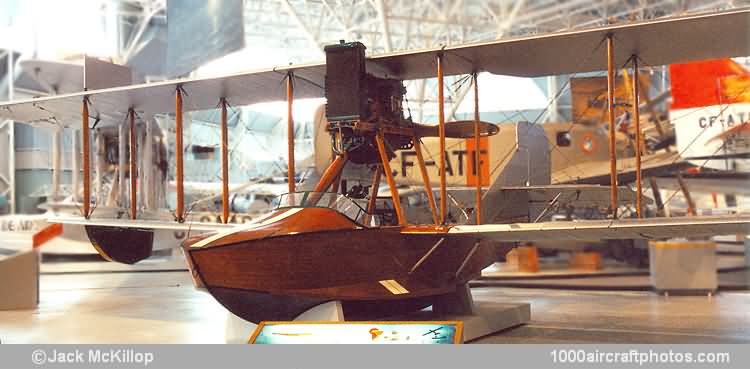09/30/2011. Remarks by Jack McKillop: "The Model 18 Seagull was a development of the Curtiss Model F of 1913 which was the world's first successful flying boat. This was a two-seat, open cockpit biplane powered by a 75 hp Curtiss O eight-cylinder liquid-cooled V-engine mounted in a pusher configuration. The aircraft was made entirely of wood with fabric covered wings and tail surfaces.
In 1914 a new, standardized Model F, also known as the F-Boat, was built and was significantly different from its predecessor. The wings were equal span and the hull had a rounded wood veneer foredeck. A similar but more powerful engine, an 100 hp Curtiss OXX-3, was used in a pusher configuration. The US Army purchased four Model Fs and the USN bought 154 as trainers. Production continued into 1918.
In 1918, the Model 18 MF (Modernized-F) appeared powered by an 100 hp OXX-6 engine in a pusher configuration. This aircraft had many improvements including sponsons on both sides of the forward hull for stability and a flat-sided hull. Curtiss built six MFs for the USN while the Naval Aircraft Factory in Philadelphia, Pennsylvania built another eighty beginning in 1919.
In 1920, Curtiss decided to build the Model 18 Seagull, a civil version of the Model MF that could accommodate up to four people. This version was powered by an 160 hp Curtiss K-6 six-cylinder liquid-cooled in-line engine still in a pusher configuration. The Seagull was a failure as a commercial venture because of the number of war surplus former Navy MF flying boats on the market and only about sixteen were built.
The Canada Aviation Museum's Seagull was the first aircraft to explore the upper Amazon Valley in Brazil and during 1924-25, it conducted an aerial survey of the Parima River headwaters in northern Brazil. It was donated to the South Kensington Science Museum in London, England, where it was slightly damaged in a bombing raid in 1941. Initially on loan, it finally came into the Museum's collection in 1968 in exchange for a Douglas (DC-3) Dakota nose-section and was restored to its present condition by Museum staff."
